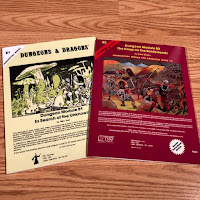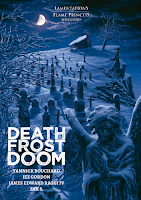The party stops outside Mordoch’s lab and decide to take
the passage south – the one passage in this area they had yet to explore. They
oil the door to keep it from squeaking. They move into a room where they find a
roomful of discarded weapons in poor condition. After breaking into a cabinet
and chest, once Pater failed at picking the lock, the group finds a small
arsenal of weapons in good condition, including a nice suit of chainmail and a
sword which are obviously of special make. In opening the chest and cabinets,
they attract a group of three ghouls with the noise they make. The battle is
over quickly, but Nyphus is struck and paralyzed for a couple of turns. While
he recovers the others hide the usable weapons and take the exceptional
chainmail and sword with them.
They move through the passage west until they reach
another room of similar size and shape. This room contains a pedestal with an
offering basin on top. Pater discovers small cones of incense inside a
compartment in the pedestal. The walls are covered with ancient-looking murals,
fresco-style of a primitive tribe of people kneeing and genuflecting towards
the passage west. The group continues onward.
Further on, the passage ends with two huge, bronze doors.
Pater attempts to pick the lock, and succeeds. The lock gives with a loud
clunk, but the door does not open. They then try to force them open through
brute strength, but to no avail. Mel casts Detect Magic both on the door as
well as the armor and sword. All three show a magical enchantment. Nyphus dons
the new armor and Renic chooses the sword. Pater goes back to light the incense
to see if that helps open the door. He returns and further attempts are made,
but with no affect.
The group then hears human voices coming from the mural
room. Wary, they go back to find the room filled with close to a dozen men and
women in ragged clothing. The incense freed them from their prison within the
walls’ mural. They speak a crude and archaic dialectic of the common tongue.
They were members of the barbarian tribe who lived in the fortress two
centuries ago. As the fog clears in their heads they can remember their
complicity in the awful crimes against their own children. Mel makes an attempt
to comfort them and gently tells them where they are at. They tell the party
they do not wish to stay in the fortress.
The party begins to lead the newly-awakened tribe members
out of the dungeon. Reaching the second floor, they can see the kobolds moving
things through the entry chamber down the hall. They creep past the creatures
undetected. As they head up the north passage, they hear, then see the two,
unfriendly black-robed men they met a couple weeks earlier entering a room to
the west. They follow them into the room which is empty. Mel finds a secret
door in the corner and they continue down a back passage west out of the
dungeon. The dungeon opens out into a cave where a small pack of wolves have
been slain.
They come out of the cave onto the western slope of island
outside of the fortress close to where they hid their boat. They notice their
boat is gone. Coming out from the trees and underbrush they saw the two figures
crossing the river with two boats (their own and the party’s). Waiting until
they are out of site, the group follows down to the river. Nyphus strips down
and swims the channel to retrieve a boat. It takes some time to get the entire
group including the dozen barbarians to the other side.
Grelda confronts them in her front yard and asks them to
come inside her home. They leave the barbarians upstairs while Grelda leads the
PCs to the basement where she presents the two robed men, tied up.








